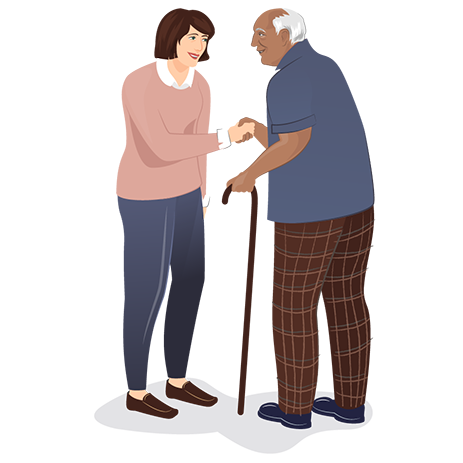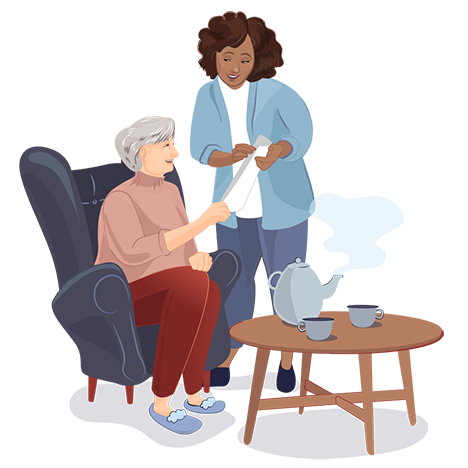
How Live in Care Can Help With Mobility Issues



Speak to one of our experts
Our friendly experts are here to help from 9am to 7pm, 7 days a week.
Losing your mobility can be a difficult time. This article explores the common signs of loss of mobility, and also discusses how elderly live in-care can help.
Signs of loss of mobility
There are a few signs that indicate when someone is losing their mobility. These may become more obvious as the frequency and severity of mobility difficulties increase, however, it is a good idea to be on the lookout for mobility difficulties early on so as to prevent any potential falls in the future. Loss of mobility is common as we grow older but it may also indicate more serious health problems, so it is always important to be able to identify signs. 
Balance
Good balance is important to be able to walk, get up from a seated position, climb stairs and bend over without falling. Balance allows us to stay independent and to carry out daily activities. Balance issue may be obvious when someone seems unsteady when they are walking or if you have noticed they are holding onto furniture in order to steady themselves. Balance relies on three main systems within our bodies. These are the visual (eyes), vestibular (inner ear) and somatosensory (sensory feedback from our joints). As we get older it is not so easy to integrate all these systems together so balance can worsen and make us more prone to falls.
Falls
An increase in falls may indicate a loss of mobility. This is probably the most dangerous outcome of a loss of mobility in older age because with the addition of brittle bones that occur with ageing, a fall may lead to broken bones and a need for hospitalisation. Falls can occur due to unsteadiness and balance problems, or due to a loss of muscle strength.
Difficulty with getting up
Someone with mobility difficulties may have difficulty standing up from a seated position, or they may have difficulty with getting in and out of bed. This can cause a loss of independence and a reduced ability to carry out everyday activities.
Trips
Someone with mobility difficulties may be more likely to trip over things or even trip up under their own feet. This can lead to an increase in falls in older people as their reflexes are slower and therefore a trip can turn into a fall more easily.
Holding on to things
In order to steady themselves if they have balance difficulties, older people may have a tendency to hold onto things as they navigate their way in the world. This can be anything from furniture around the house to people walking with them or objects in the vicinity that the person can hold onto in order to have support when they walk.
When to start considering elderly live-in care
The appropriate time to arrange live-in care depends on the needs of your loved one. Below are examples of when to consider live-in care:
When there is a higher risk of a fall
Mobility difficulties can lead to an increased chance of falls. Falls are particularly dangerous in the elderly since their bones are more brittle leading to an increased likelihood of broken bones and, if an operation is necessary, recovery times are likely to be longer due to slowing of vital bodily functions.
When your loved one feels lonely
As well a real risk of falling over, mobility problems can also lead to your loved one feeling less independent and more isolated, as they may not be able to get around as easily as they once did.
When household tasks are difficult
Carrying out household tasks may be more difficult for your loved one who is limited in their mobility and this can be disheartening for them to come to terms with. A live-in carer can provide opportunities for your loved one to engage more in daily activities and social connections that they may have lost the ability to do by themselves. A live-in carer can support them to feel safe during these times and to encourage them to stay mobile.
Be aware that your loved one may be resistant to the idea of a carer and they may tell you that they are coping fine on their own. This is quite common because it can be difficult for older people to come to terms with the idea that they may be losing some of their independence. It can also be quite a big change for them to have something live-in with them. If you are met with resistance, it is a good idea to speak through with your loved one about your concerns and to understand more about their concerns and fears. There are intermediate options that you can consider before a live-in carer such as getting a lanyard that can alert emergency services if your loved one does have a fall or a carer that comes in at certain times during the day or night to help your loved one. However, with mobility difficulties, there can be ongoing challenges that become noticeable throughout the day and therefore having someone living in with your loved one can be the most reassuring option for you and your family.
What is mobility care?
Mobility care relates to how elderly live-in care can be provided which can help your loved one with things they struggle with due to their reduced mobility. Elderly live-in care includes helping your loved one to not put themselves in situations where a fall may be more likely, such as trying to reach something from a top shelf or walking long distances to the shops. Therefore, a mobility carer can identify areas that your loved one needs support with and they can try to create a supportive and safe way of improving these areas for your loved one. This can include anything from helping with grocery shopping, household tasks, encouragement with exercises or helping them up and down the stairs.
How elderly live-in care can help
Elderly live-in care and assistance with mobility can provide support for all kinds of mobility difficulties and different types of physical disabilities. The level of care provided is dependent on the needs of your loved one.
A mobility carer can help your loved one to:
- Stay active and engage in regular exercises that can strengthen muscles, improve balance and increase flexibility.
- Eat healthily and prepare foods that are nourishing and helpful for strengthening the body.
- Identify hazards within the home and help to reduce the risk of falls by ensuring things like rugs are secure and helping to move wires that may be trip hazards.
- Improve lighting within their home so that your loved one can move around the house at all hours without a lack of light, which could lead to a greater chance of falling.
- Speak with their doctor about any medical needs your loved one may have.
- Adjust to using a walking aid, if this is required.
- Ensure that their vision and hearing are regularly checked by professionals.
- Make sure that they are putting on footwear correctly and that they are using suitable footwear for the activity they are undertaking.
- Socialise and get out and about more, especially if your loved one is no longer driving and/or they have challenges with getting public transport.
How we can help
Our team of live-in care specialists can help you find a suitable carer for your elderly relative or loved one, ensuring they maintain their dignity and independence. Your loved one can form friendship and companionship with a live-in carer at home. Explore our live-in care services or contact our friendly team to begin consultation and arrange care today.






